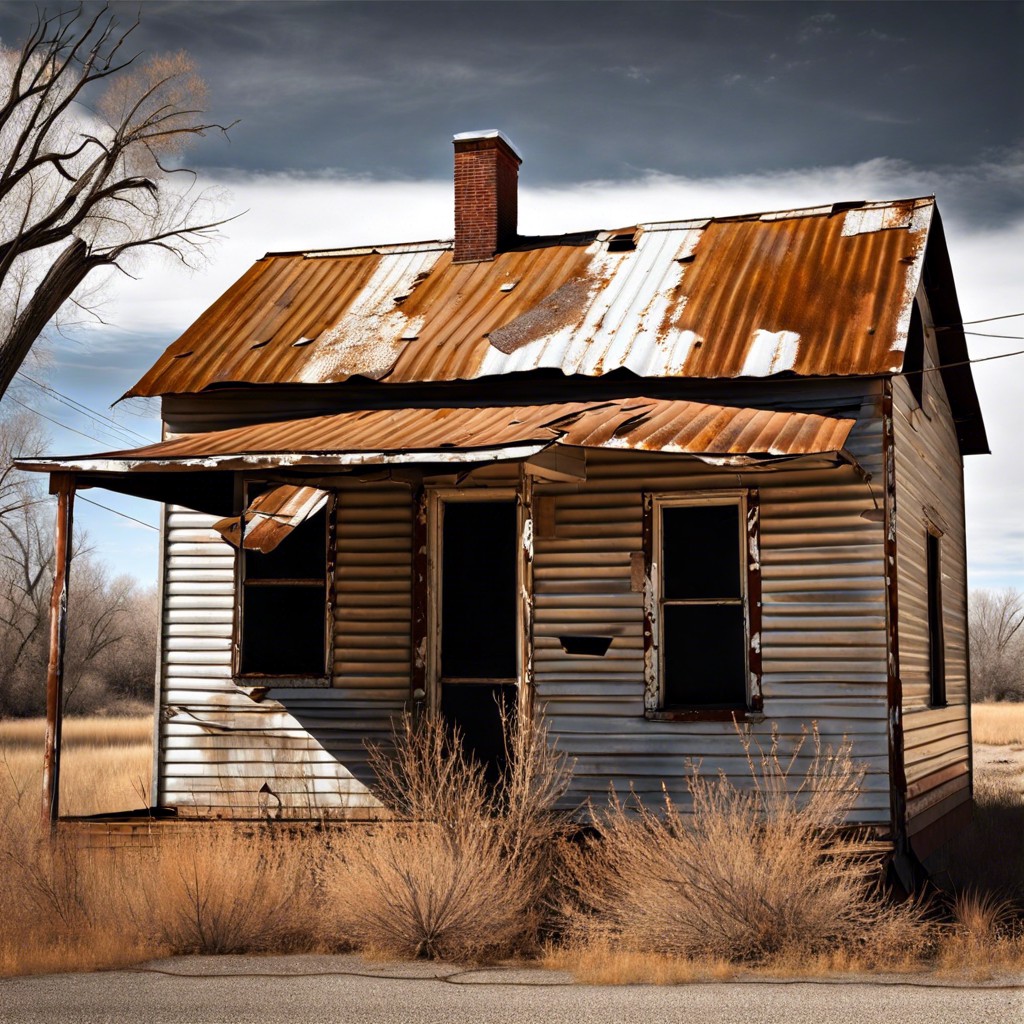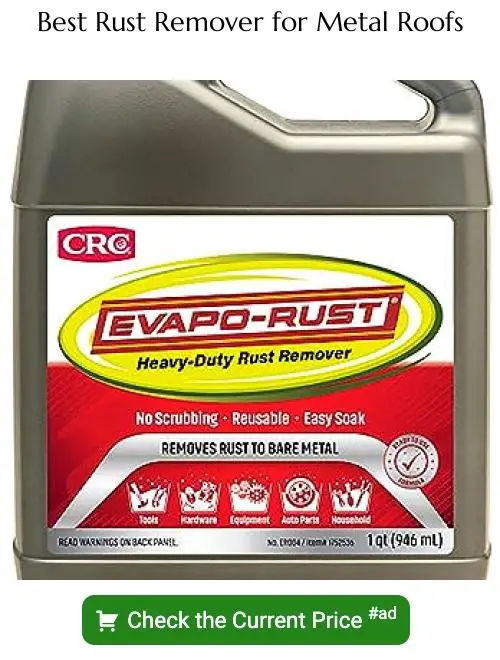Last updated on
Discover the causes, prevention methods, and remedies for rust on tin roofs in this comprehensive guide.
Key takeaways:
- Tin roofing develops rust due to exposure to the elements.
- Corrugated tin and standing seam are popular rustic roofing options.
- Rusted metal roof cost depends on factors like material, design, and finish.
- Alternative options for rusted metal roofing include pre-rusted panels and metal roof coatings.
- Consider the grade, corrosion resistance, and climate when choosing rusted metal roofing.
What Is Rusted Tin Roofing?

Tin roofing, traditionally made from sheets of rolled tin-coated steel, has been a durable and lightweight roofing material for centuries. Over time, exposure to the elements can lead to the unmistakable appearance of rust on these roofs, which is often seen as a mark of character and rustic beauty.
This patination process occurs when the protective tin coating wears away and the steel beneath oxidizes, creating a layer of iron oxide. While some homeowners appreciate the aesthetic of a naturally rusted roof, it’s crucial to note that this corrosion can also signify aging and potential deterioration.
Properly maintained, a tin roof can last over 50 years, but once corrosion sets in, it can compromise the integrity of the roofing material. Modern alternatives to traditional tin roofs, such as metal panels with a rusted finish, offer the desired aesthetic without the risk of structural damage.
Types Of Rustic Metal Roofing
Corrugated Tin: This classic design is characterized by its wavy pattern, which not only contributes to its rustic charm but also enhances its durability by providing structural support against the elements.
Standing Seam Metal: Often made from steel, aluminum, or copper, standing seam varieties offer a more modern take on rustic roofing. These panels boast a series of raised seams where they connect, creating a sleek, contemporary look.
Weathering Steel (Corten): Known for its distinctive patina that forms over time, Corten steel is a popular choice for those seeking a rugged, industrial aesthetic that also provides a protective layer against further corrosion.
Galvanized Steel: Treated with a zinc coating to prevent rust, this option offers a shiny, metallic finish initially, which gradually dulls to a soft gray, blending seamlessly with rustic environments.
Stone Coated Steel: These materials mimic the texture of stone and traditional roofing tiles. Stone chips adhere to the metal, providing a multi-textured, dimensional surface that pairs well with a variety of architectural styles.
Aluminum: A lightweight and rust-resistant alternative, it can be treated to mimic the rustic appearance of more traditional metals, accommodating homeowners looking for durability without heavy maintenance.
Pre-Rusted Panels: Some manufacturers provide metal roofing that has been pre-rusted, allowing for controlled corrosion that offers the desired aesthetic immediately after installation with no waiting period.
Rusted Metal Roof Cost
Understanding the cost of rusted metal roofing requires considering several factors. The price of a rusted metal roof is influenced by the type of metal, the complexity of the roof design, and the market demand for specialized finishes.
- Material Costs: Corrugated tin, for example, is relatively inexpensive compared to copper or zinc, which can develop a patina that mimics rust. Steel, commonly used for metal roofing, can be treated with weathering steel (Corten), designed to rust in a way that protects the metal underneath from further corrosion.
- Size and Design: A larger roof area increases material requirements and labor, affecting the overall price. Complex roof designs with multiple slopes or angles may also contribute to higher labor costs due to increased installation time and difficulty.
- Finish and Coating: Pre-rusted or rust-look coatings can vary in price. Some products come with an already rusted finish, while others are designed to rust over time, a feature that might affect the cost.
- Installation: Professional installation is crucial for ensuring longevity and performance. Experienced contractors may charge more, but investing in a skilled installer can prevent costly repairs in the future.
- Geographic Location: Costs can vary regionally due to differences in labor rates, climate, and local building codes that may affect material choices and installation requirements.
When estimating the total cost, homeowners should request detailed quotes from contractors that include all of these elements to ensure accurate budgeting.
Alternative For Rusted Metal Roofing
For homeowners who desire the rustic aesthetic of a rusted tin roof without the potential downsides, there are alternatives that capture a similar visual appeal with added benefits:
1. Pre-Rusted Metal Panels: Manufacturers produce pre-rusted metal roofing material that offers the weathered look immediately upon installation without waiting for the natural rusting process.
2. Metal Roof Coatings: Applying a coating designed to mimic a rusted finish can protect the metal from actual corrosion while bestowing the appearance of age.
3. Aluminum and Copper: These metals develop a protective patina over time, much like rust, but without the structural degradation associated with iron oxide on steel.
4. Painted Steel Panels: Steel roofing panels with specialized rust-colored paint provide the look of rust without compromising the integrity of the roof material.
5. Weathering Steel (Corten): This steel alloy is designed to form a stable, rust-like appearance after exposure to the weather and eliminates the need for painting.
6. Galvalume Roofing: A combination of aluminum, zinc, and silicon coated steel. Though it doesn’t rust, it provides a similar matte and muted appearance over time.
Choosing The Right Rusted Metal For Your Roof
When selecting rusted metal roofing, prioritize the material’s grade and corrosion resistance to ensure longevity. Consider the climate and environmental conditions of your area, as moisture and salt can accelerate rusting. Opt for a coating such as zinc to enhance durability.
Gauge thickness also matters; thicker metal withstands weather elements better. Ascertain the patina effect you desire; a uniform look or a variable pattern, as this will inform the type of metal and treatment required.
Lastly, ensure compatibility with your roof’s structure and slope, and consult a professional for installation to avoid compromising the roof’s integrity.
FAQ
What does tin roof rusted mean in slang?
In slang, "tin roof, rusted" is interpreted to signify unintended pregnancy, famously used in The B-52’s song “Love Shack.”
Where did the term tin roof rusted originate?
The term "tin roof rusted" originated from a rehearsal session where the band, finding it amusing when yelled out by Wilson as their backing tape stopped, decided to use it as a suitable ending for their song.
Was RuPaul in the Love Shack video?
Yes, RuPaul was in the "Love Shack" music video by the B-52’s, released in 1989.
Who was the lead singer of the B 52’s?
The lead singers of the B 52’s were Fred Schneider, Kate Pierson, and Cindy Wilson.
What materials are typically used to prevent a tin roof from rusting?
Typically, a protective coat of either zinc, copper, or a specialized anti-rust paint is used to prevent a tin roof from rusting.
How does the weather impact the lifespan of a tin roof?
The weather significantly impacts the lifespan of a tin roof, with extreme conditions such as heavy rain, strong wind, ice, and snow potentially leading to erosion, corrosion, and structural damage.
What are the benefits and drawbacks of using tin as a roofing material compared to other alternatives?
Tin roofing, while lauded for its durability, low maintenance, and eco-friendliness, suffers from drawbacks like higher upfront cost and noise during intense weather conditions, compared to alternative materials.

